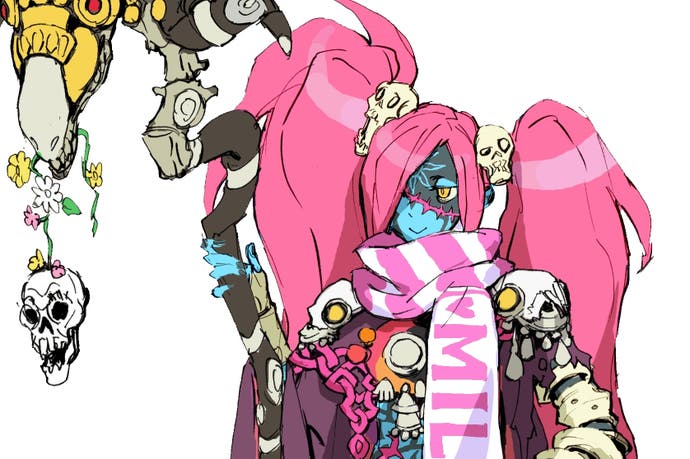Code of Princess review
Guardian heroine.
With its bright, idiosyncratic characters, scattershot humour, reeling combo counters and punchy combat, Agatsuma Entertainment's Code of Princess bears all the family likeness of a Treasure game. That's no great surprise. Creators Tetsuhiko Kikuchi and Masaki Ukyo both worked at the boisterously creative action game developer in the past, specifically in the roles of director and lead programmer on the studio's seminal Sega Saturn title, Guardian Heroes.
It's this particular game with which Code of Princess shares the most similarities. Both are scrappy fighters placed within an exaggerated European medieval setting (albeit one seen through a Japanese glass, darkly). As well as the aesthetic resemblance - rangy heroes, whose colourful robes drag on the Haribo-green grass or whose burnished armour clinks along the pixelated cobblestones of the hand-drawn backdrops - this is similarly a 2D game that plays out on a series of environments with three planes. Your character can switch plane, hopping into or out of the screen in order to escape the scrapping or to lunge, stabbing, into it.

In the main story you play as Princess Solange Blanchefleur de Lux, whose naivety and negligible armour become a running joke between her companions. Cast out of her own kingdom, she's joined by a growing cast of sympathetic fighters that she meets on the open road: Lady Zozo, a tatty necromancer built from offcut body parts pilfered from cadavers; Ali Baba, an agile and tomboyish thief; and Allegro, a cowardly guitar-playing bard who punctuates each sentence with a distorted power chord.
These characters can each be used to play through the storyline, offering a range of different play-styles (Zozo favours ranged magical attacks, Baba in-and-out slices, while Solange defies her waif-like frame by wielding a heavy broadsword) and you can switch between them after any mission. Later in the story, they're joined by a short-tempered nun, an earnest samurai and a beast man, but these additions are only playable in free-play mode.
The routine plot trips and stumbles as the team work to reclaim the Princess' kingdom, instead hoping to snag players' interest with humour - especially jokes that poke fun at genre conventions, both those of fantasy fiction and of Japanese adventure games. There's mild amusement to be found in Atlus' translation work (the animal-loving tagalong warrior Master T summons "the might of the heartbroken badger" when preparing for a special attack) but by the midway point of the story, most players will be holding down the fast-forward button to skip through to the action. The jibes at convention fall flat, too - the game follows too many of the same well-worn furrows to claim parody.

Still, story was the least of Guardian Heroes' assets; its true joy was in the ruckus. For developers, the scrolling fighting game is mistakenly considered the easier path compared to its black-belted Street and Virtua Fighter cousins. But tastes have matured and, in 2013, Streets of Rage's meagre fistful of moves isn't enough to maintain picky players' interest. We still spoil for a fight. But it can't be a boring fight; we demand spectacle and, more importantly, variety.
As such, success in this style of game is no longer accessible to a minor talent. Guardian Heroes excelled with its long, spectacular move-lists, diverse characters and the relentless pile-on of enemies who could be hurled about the screen. Code of Princess's brawlers have a much more limited number of moves, and you soon settle into your favoured routine. It's possible to lock on to enemies and, if you have enough magic points, triggering a 'Burst' attack will stun groups of nearby foes, creating an opening in which to flee or counter-attack. Even so, the fighting is both familiar and repetitious.
This problem is exacerbated by some changes to the game's structure. Gone are Guardian Heroes' branching paths, which led to a variety of different endings and were chosen through end-of-stage conundrums: decisions such as whether to kill or save the civilians, defend or crush the weak, show mercy or justice towards repentant enemies. Now each short stage is followed by the next in sequence (31 of them in all) and the objective in each only ever varies between 'Defeat All Enemies' or 'Defeat the Boss'. The only reason to replay stages is to improve your best time - but these scores aren't uploaded online, so there's no meaningful competitive point to them.

In Code of Princess you earn experience points for a victory, and as your character rises through the ranks you're given clutches of agility points to funnel into Vitality (health points), Piety (magic points), Attack, Defense, Mind (magic strength) or Speed. Your emphasis will be suited to your character choice, but it's wise to spread your training across the options, as some later enemies will target magical weakness, for example, which will empty your health bar if you're unprepared. A vast array of equipment can be collected from battles or bought from the game shop: the 'Empurrium', staffed by a greedy Egyptian cat, whose stock changes at random each time you enter.
Local and online multiplayer facilitates co-operative as well as competitive play (where you can use any of the 40-odd enemy characters you've encountered in the storyline, in another nod to Guardian Heroes), but even this soon after the UK launch, I was unable to find any other players. A mild disappointment that matches feelings about Code of Princess as a whole. It appears to have most of the constituent parts that made Treasure's 1996 title (now available on Xbox Live Arcade) so joyous, but problems in structure and detail spoil the whole. It's a tribute act: one that initially delights through recognition, but ultimately feels hollow and counterfeit.









